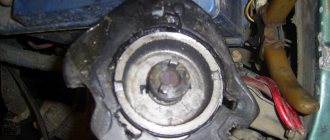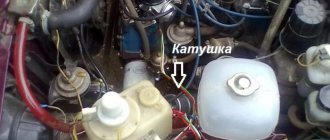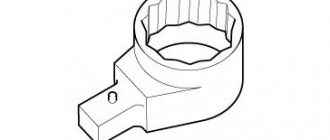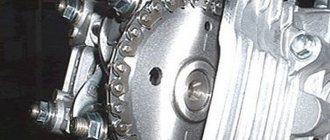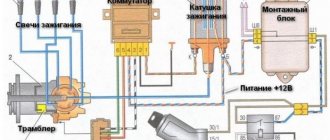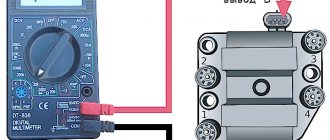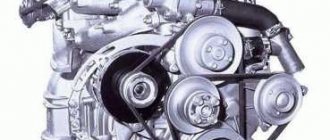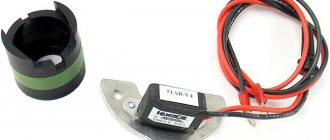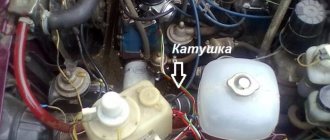Incorrectly set ignition leads to car breakdown
Most owners of VAZ 21099 cars have probably had problems starting the engine when, when turning the key inserted into the ignition switch, the engine starts to work, but does not hold idle speed at all. Why is this happening? One of the likely causes of this and some other malfunctions may be an incorrectly set ignition, but if the spark plugs are flooded or there is no spark when starting the engine, then it is better to immediately look for the problem in the carburetor.
On a VAZ 21099 with a carburetor engine, eliminating the problem of incorrect ignition adjustment with your own hands is quite simple, but you will need a special tool - a strobe light. It is advisable to purchase it for your own use, because you will have to adjust the ignition timing more than once over the long life of the car. How to set the ignition correctly and without difficulty?
Setting the ignition timing (ignition timing) on VAZ-2108, 2109, 21099 cars
Setting the ignition timing
(ignition timing)
on VAZ-2108, 2109, 21099 cars
(second slide)
Setting the ignition timing is one of the main settings of a car engine. Incorrectly set ignition (both in the direction of increasing the advance angle and in the direction of decreasing) immediately affects its operation for the worse.
Signs of incorrectly set ignition timing
overheating, detonation, shots into the muffler or carburetor, this is not a complete list of such malfunctions.
It should be borne in mind that similar symptoms occur with an incorrectly adjusted or faulty carburetor, faulty valve mechanism, etc.
Purpose of setting ignition timing
Set the optimal ignition timing at which the main characteristics of the car engine - power, throttle response, idle speed, fuel consumption - will be normal.
Tools for work
— Tachometer
(you can use the built-in one in the instrument panel, you can connect an external one (for example, an auto tester, a multimeter in tachometer mode), you can use your ear, if you have experience).
strobe and autotester -
Socket or open-end wrench.
Either a matching ratchet socket or an L-shaped wrench. Size 10.
— We warm up the car engine to operating temperature (85-90)
.
— Set the minimum idle speed (750-800 rpm)
. To do this, turn the “amount” screw of the fuel mixture on the carburetor. You can set the minimum speed using the tachometer or by ear. If they correspond to the norm, then we skip this point.
location of the adjusting screw for the “amount” of the fuel mixture on the carburetor 2108, 21081, 21083 Solex - Remove from the fitting on the housing of the vacuum ignition timing regulator
,on the distributor-distributor, a silicone vacuum supply tube coming from the carburetor.
—
We check by placing a finger on its hole to see if there is a vacuum in it.
It shouldn’t be there, since in theory it should start working at speeds above 800. If it is, slightly reduce the idle speed (by rotating the “amount” screw of the fuel mixture on the carburetor) until it disappears.
— We plug the hole in the silicone tube with a small bolt or simply bend it in half (tie it in a knot).
— Using a 10mm wrench, loosen the three nuts securing the breaker-distributor housing.
— We are looking for a hatch on the gearbox housing with a scale and a visible part of the flywheel. It is usually closed with a rubber stopper.
We remove the plug.
location of the inspection hatch in the clutch housing on VAZ 2108, 2109, 21099 cars -
Wipe the scale in the hatch with a rag so that the installation marks are clearly visible on it.
— Use a screwdriver to turn the flywheel by the teeth of its crown and find a long transverse alignment mark on it.
When it stands opposite the triangular cutout on the scale in the hatch, it means that the ignition timing is 0 0, and the pistons of the first and fourth cylinders have risen to top dead center. If it is poorly visible due to oiling or contamination, we wipe the edge of the flywheel through the hatch until we find it. You can highlight the mark with chalk.
mark for setting the ignition timing on the flywheel and a scale with degrees
— We check whether this is a risk (what if your flywheel is installed incorrectly).
We check using the following marks - the long mark on the flywheel should be opposite the triangular cutout on the scale, the mark on the camshaft pulley should be opposite the protrusion on the rear timing belt cover (to see them, remove the plastic timing belt cover).
How to set the ignition on VAZ 2109 injection models
The VAZ 2109 with an injector is equipped with an electronic ignition system module. Those. configuration occurs by programming and flashing the control unit. It is impossible to adjust the system without specialized equipment.
Setting up ignition using a strobe light
The ignition angle is adjusted and checked at idle speed. The number of crankshaft revolutions should be in the range of 800 - 900 rpm.
- The engine is warmed up to 90 C.
- Crankshaft rotation speed 800 – 900 rpm. If the frequency becomes higher, check the carburetor fuel assembly.
- The vacuum tube is disconnected from the fitting and the engine is turned off.
- The tube is bent in the middle with a screw, then the securing nuts of the distributor-breaker are unscrewed.
- The rubber plug is removed from the gearbox housing. This is where the flywheel inspection hole is located.
- The cylinder wire is disconnected from the shaft cover, and a strobe light is attached in its place.
- They start the car. The device (strobe) will send signals to the flywheel.
- The distributor shaft is rotated until the mark on the mark coincides with the mark on the flywheel.
- The mark is marked. If the mark on the flywheel matches the mark on the crankshaft pulley, then the setting is correct.
How to set the ignition on a VAZ 2109 using an incandescent lamp
To debug the ignition using an incandescent lamp, you will need a 10 mm key and a 12 Volt light bulb. Ignition adjustment occurs by loosening the fastenings of the spark system sensor.
The procedure for setting up the light bulb is as follows:
1) Turn the crankshaft with a wrench until the marks match. If there is no key, then you can set the fourth speed at idle and push the car until the marks coincide.
2) A lamp is connected to the cable that connects the breaker and the ignition coil.
3) Using the other two wires, the light bulb is connected to the ground of the VAZ 2109.
4) Loosen the bolts on the distributor and start the car. The incandescent lamp should light up.
5) The distributor body is turned to the right until the lamp goes out. Afterwards, the body is smoothly rotated to the left. After the lights come on, they stop.
6) Tighten the housing mounting nuts.
This method is most suitable for self-tuning the spark generation system.
Setting up tachometer markers
In order to set up the ignition using this method, two people are needed. One will be in the pit and rotate the distributor, the second will be located in the car interior.
The tachometer setting is done as follows:
- Turn on the ignition and watch the arrow of the device.
- A person in the pit cushions the mounting nuts and bolts of the distributor and turns it.
- The ignition key is turned, the tachometer indicator jumps and returns to 0.
- If the distributor remained in the location to which it was turned when the instrument needle deviated, it means that the adjustment of the ignition structure was correct.
How to check the ignition module of an injector with 8 valves?
Before setting up the ignition of an injection engine, you will need to prepare:
- laptop with ID diagnostic program;
- tester;
- keys, screwdriver.
Before checking the VAZ 21099 ignition module, it is necessary to monitor the components of the control system. Everything must be connected and working properly; if necessary, the required parameters must be adjusted. Turn on the ground and ignition, while gasoline is pumped. When a red light appears, diagnose problems on the car’s on-board computer and the PC connected to it.
Check the throttle device: turn on the ignition, use a tester to check the voltage values for the on-board network and the sensor. Reference diagram of indications: BS voltage - more than 12 volts, sensor voltage - approximately 0.5 volts, opening degree - up to 1%.
Before removing the module, monitor all system components
When the gas pedal is pressed, the sensor voltage readings and the throttle opening degree will change: approximately 4.5 volts and at least 90%, respectively. It is best to achieve 100% throttle opening.
Next, you should turn off the additional air flow regulator, achieve 50% opening of the throttle for air flow when starting the engine easily in a warm state. Then adjust the throttle so that it is completely closed.
Purpose of the distributor cover
The design of the ignition distributor cap (aka distributor) has remained and remains virtually unchanged throughout the entire history of the use of this device as part of the ignition system of gasoline engines:
- On most ignition caps, the contacts for the spark plug wires are marked with numbers that correspond to the serial numbers of the corresponding cylinders
- In addition to protecting the distributor mechanism itself from moisture and dirt, it also serves the purpose of alternating the supply of high-voltage current from the ignition coil winding through high-voltage wires to the spark plugs
- It is because of this narrow specialization that the distributor cap has undergone almost minimal changes along the evolution of all car systems
Let's look at the design and operating principle of this much-needed part.
The distributor cap is a molded part made of non-electrically conductive material (insulator) that has the following device:
- Metal contacts are pressed into this part - these are the side and central electrodes
- The number of side electrodes strictly corresponds to the number of engine spark plugs (but not cylinders, do not forget that there are engines in which there is more than one spark plug for each individual cylinder); the distributor cover on the VAZ 2109 in our case has four side electrodes
- A high-voltage (armor) wire coming from the ignition coil is connected to the central electrode from the outside
- To the side electrodes - high-voltage (armor) wires going to the spark plugs
- Inside the cover itself there is a central contact equipped with a terminal that has a spring-loaded contact element (“carbon”), which transmits voltage to the central (main) contact of the distributor rotor (ignition distributor)
Schematic design of the lid
When installing the cover on the distributor body, it is important to take into account not only the order of connecting the armored wires, the orientation of the cover in relation to the “nose” of the runner is also important. The ignition distributor cover is attached to the distributor body using latches or screws (the distributor cover on the VAZ 2109 is secured with screws) To prevent the formation of condensation under the lid, it has a special ventilation hole
Terminology
Ignition distributor
- an electromechanical device that ensures timely supply of high voltage pulses to the spark plugs.
It is often called a distributor
.
Ignition advance
- ignition of the working mixture in the cylinder before the compression stroke ends.
Ignition timing (IDA)
— the angle of rotation of the engine crankshaft from the position corresponding to the appearance of a spark on the spark plug until the piston reaches top dead center.
Contact ignition system
- a system in which switching of the ignition coil is provided by a mechanical interrupter.
Contactless ignition system
- a system in which switching of the ignition coil is provided by an electronic module controlled by an electronic crankshaft position sensor - for example, a Hall sensor (VAZ-2108) or magnetoelectric (GAZ-2410).
Breaker
ignition system - a mechanical switch in the distributor, directly connected to the primary circuit of the ignition coil.
Runner
- a distributor element that alternately transmits high voltage from the ignition coil to high-voltage wires connected to the engine spark plugs.
Angle of closed state of contacts (UZSK)
- a value indicating how long the contacts of a mechanical breaker should remain closed. For classic Zhiguli cars, the UZSK is approximately 55 degrees. A correctly selected UZSK gives the ignition coil the opportunity to gain the necessary energy and completely transfer it to the spark plugs.
Do-it-yourself ignition system repair
So, if problems with the engine indicate problems with the ignition system, you should proceed with immediate repairs. The essence of the work being carried out comes down to installing or setting the correct ignition timing. The engine will only run stably when you adjust the ignition system. To begin repairing this mechanism, you need to stock up on some tools:
- strobe;
- tachometer;
- flat screwdriver;
- key to 10.
Having a strobe light on hand will greatly facilitate the process of setting up the ignition, so we recommend purchasing one for personal use.
Before you start setting the ignition timing and angle, do some preparatory work. The first thing you need to do is start the engine. Then either wait or rev the engine until the engine temperature is 90 degrees Celsius and the idle speed should be around 800 rpm (use a tachometer to determine this parameter). To obtain the required values, use the fuel regulator located on the carburetor body.
As the engine operating temperature reaches 90 degrees, remove the silicone tube through which the discharge occurs from the fitting. The lever for adjusting the fuel supply is located on the ignition timing distributor panel or distributor. The distributor is attached to the carburetor itself. Place your finger on the other edge of the tube and check if there is a vacuum effect. It can be checked very simply: if your finger is stuck to the tube, it is there; if not, then there is no effect either. Now you need to reduce the number of revolutions until the vacuum completely disappears.
Then turn off the engine. Bend the silicone tube so that there is no gap. Take a 10mm wrench and unscrew the distributor nuts. The photo above clearly shows the flywheel and crankcase hatch. The gearbox housing contains a hatch with a flywheel scale. Remove the plug and, if there is dirt, wipe it off the inspection hatch. On the scale you will see stripes responsible for correct ignition setting. Next we focus on them.
Using a flathead screwdriver, rotate the flywheel to the long line on the scale. Before setting the ignition, you need to align the long strip exactly opposite the triangular cutout on the scale. The fact is that this position means a zero ignition angle. At the moment when the long strip is in this position, the first and fourth cylinders remain in a fixed position.
If, due to poor visibility, you doubt that the selected strip is the longest, it is worth re-evaluating its location relative to the camshaft. To do this, you need to remove the timing belt cover and see if the mark you are interested in matches the mark on the rear cover.
Next you need to use a strobe light. To connect it, you need to perform several simple manipulations:
- first connect the red wire to the positive on the coil;
- then place the dark wire anywhere on the body;
- and secure the mount to the fourth cylinder along with the wires.
Before connecting the device, it is better to read the instructions for use.
How to regulate
Practice shows that most often problems with the ignition system are observed in older models with a carburetor type of power plant.
To perform the setup you will need the following tools:
- Screwdriver Set;
- strobe light (you can basically do without it, but with its help you can set the angle more accurately);
- 10mm wrench (suitable for both socket and socket wrenches);
- tachometer (it is available in almost any car multimeter).
I will give advice on installing the timing belt (the toothed belt that is placed on the camshaft).
If your eight or nine was assembled by a would-be master who installed the flywheel incorrectly and the top dead center mark turned out to be turned 180°, but then he realized that he had messed up and simply put the belt on the mark of the front pulley and not on the flywheel, but you don’t know this, then When you install the belt according to the marks on the flywheel and camshaft pulley, and try to start the engine, all the valves will bend. I know many cases when the timing belt of cars broke and people put the belt on the marks of the camshaft and flywheel and bent the valves, and all because when assembling the engine, the would-be master screwed the flywheel incorrectly.
instructions and purpose
Let's first consider the general purpose, design and types of distributors:
- The distributor is part of the ignition system, and is designed to regulate, transmit and control the electrical signal to the distribution coil switch, igniting the spark along the spark plugs in the required accordance (in sequence with the ignition stroke)
- There are two types of ignition systems - non-contact and contact (of course, there are others, but they are not very common), accordingly, distributors are also used of two types
- friend They differ from each other only in design: the presence of contacts (in a contact system there is a breaker), a sensor distributor (in a contactless ignition sensor system there is a distributor)
- According to the main characteristics, both systems are almost identical
On VAZ-2109 cars, as well as 2108 models-2199, a distributor with a built-in Hall sensor, four spark, with built-in centrifugal (regulators and vacuum) ignition timing is standardly installed. You can see the main details in the photo above:
- 1 - sealing ring
- 2 - special
- 3 – coupling adjusting washers
- 4 - roller with a centrifugal regulator located on it
- 5 — support plate
- 6 – screen, protecting from dust
- 7 - the so-called “runner”
- 8 - Hall sensor itself
- 9 — lock washer
- 10 - thrust washer
- 11 — distributor, ignition housing
- 12 — vacuum corrector
Adjusting the ignition timing
Ignition timing is the moment a spark occurs at the spark plug electrodes. It is determined by the angle of rotation of the crankshaft journal relative to the top dead center (TDC) of the piston. The ignition angle has a noticeable effect on engine performance. If its value is too high, ignition of the fuel in the combustion chamber will begin much earlier than the piston reaches TDC (pre-ignition), which can lead to detonation of the fuel-air mixture. If sparking is delayed, this will lead to a decrease in power, engine overheating and increased fuel consumption (delayed ignition).
The ignition timing on the VAZ 2106 is usually set using a car strobe light. If there is no such device, you can use a test lamp.
Setting the ignition timing using a strobe light
To adjust the ignition timing you will need:
- car strobe light;
- key to 13;
- a piece of chalk or a correction pencil for printed text.
The installation process itself is carried out in the following order:
- We start the car engine and warm it up to operating temperature.
- Disconnect the hose from the vacuum corrector located on the distributor body.
- We find three marks (low tide) on the right engine cover. We are looking for the middle mark. To make it better visible in the strobe beam, mark it with chalk or a correction pencil.
Video: adjusting the ignition using a strobe light
Setting the ignition timing using a warning light
To adjust the ignition using a lamp you will need:
- the warning lamp itself;
- 36 head with handle;
- key to 13;
- 16mm spark plug wrench with wrench.
The work order is as follows:
- Using a 36mm socket, placed on the crankshaft pulley ratchet, we rotate the shaft until the mark on the pulley aligns with the casting on the cover. When using gasoline with an octane rating of 92 and higher, the mark on the pulley should be aligned with the middle ebb. If the octane number is less than 92, the mark is placed opposite the last (long) ebb.
- We check whether the distributor is installed correctly in this position. Unfasten the latches and remove the distributor cover. The outer contact of the distributor slider should be directed towards the spark plug of the first cylinder.
Video: adjusting the ignition using a light bulb
Installing the ignition by ear
If the valve timing is set correctly, you can try to set the ignition by ear. This is done as follows.
- Warm up the engine.
- We drive out onto a flat section of the highway and accelerate to 50–60 km/h.
- We switch to fourth gear.
- We sharply press the accelerator pedal all the way and listen.
- With the ignition set correctly, when the pedal is pressed, a short-term (up to 3 s) detonation should occur, accompanied by the ringing of the piston pins.
If detonation lasts more than three seconds, ignition is early. In this case, the distributor body is rotated several degrees counterclockwise, and the verification procedure is repeated. If there is no detonation at all, the ignition is late, and the distributor body must be turned clockwise before repeating the test.
When and why do you need to adjust the ignition?
First, a little theory. If the working mixture in the cylinders burned instantly, then there would be no problems with advance in principle. Set it on fire at top dead center and everything is fine. But the mixture does not burn instantly: it takes milliseconds. In this case, the actual rotation speed of the crankshaft is, of course, not constant. Therefore, you cannot stupidly ignite the mixture at the same time under different engine operating modes: it will burn either too early or too late. The result will always be disappointing - the engine pulls poorly, overheats, runs unstably, detonates, etc.
In particular, if you start “sparking” too early ( large
), then the gas pressure will increase sharply until the piston reaches top dead center, preventing its movement.
Because of this, the power will decrease and the efficiency of the engine will deteriorate, it will lose throttle response and will jerk at low speeds. With late sparking ( low CV
), the mixture will burn for a long time with an expanding volume, and therefore the gas pressure will be significantly lower than the calculated one. Power and efficiency will decrease, and the engine will overheat greatly, since the mixture will burn out throughout the entire expansion stroke.
There is only one treatment method - ignite the working mixture according to the speed and load on the engine. In addition, adjustment of the OZ may be required when switching to gasoline with a different octane number. By the way, on very ancient cars (at the beginning of the last century), the ignition timing was regulated by the driver: a special handle was provided. But it soon disappeared, because the engine acquired a distributor with a centrifugal mechanism inside.
What do ignition malfunctions promise?
Difficulties in starting the power unit, strange color of exhaust gases, incorrect operation of the engine at idle speed - all this can be the cause of incorrectly adjusted ignition timing.
At the same time, many car enthusiasts blame the carburetor and spend a lot of time cleaning or repairing it. As a result, money and time are wasted, but there is no result.
On the other hand, if the ignition system does not produce a spark, and the spark plugs are regularly filled, then the problem may lie elsewhere.
An incorrectly set angle manifests itself as follows:
Currently reading
Lada Largus FL 2022 in a new body or everything new, not yet forgotten old
1.1k
Chevrolet Niva: a good purchase or a headache, is it worth buying on the secondary market?
23.2k
1. Powerful detonation appears during operation of the power unit.
It is not difficult to recognize the problem. The main symptom is an uncharacteristic ringing sound that is heard when you press the accelerator pedal.
This malfunction is a common occurrence among motorists who do not properly monitor the condition of their vehicle.
The cause of detonation is early ignition timing, which not only reduces the comfort of driving a car, but can also lead to deformation of the pistons.
Alternatively, the rings may be defective, which in this case will inevitably have to be replaced.
2. The appearance of smoke from the exhaust pipe.
— after starting the power unit, black smoke comes out of the exhaust pipe. This problem is a clear indication of pre-ignition.
3. Motor power decreases.
This is especially noticeable when the vehicle picks up speed.
There may be a delay of several seconds between pressing the gas pedal and the car starting to accelerate. If the car starts to accelerate, it happens jerkily.
4. Fuel consumption increases.
One of the main consequences of incorrect system configuration. This and the problem described above are evidence of late ignition.
This is explained by the fact that when the piston reaches the top point, the fuel mixture does not burn completely and continues to burn even when the piston moves back.
5. Uneven idle.
An incorrectly set ignition immediately manifests itself as engine malfunctions at idle.
In such a situation, experts recommend setting up the system first, and only then starting to check other systems.
Basic technical concepts
The ignition system is a variety of interconnected instruments and devices that guarantee the appearance of an electrical discharge, which in turn ignites the mixture of fuel and air in the internal combustion engine system. This system plays a huge role in the vehicle’s technical equipment and electrical equipment.
We are not interested in the entire ignition system, but only in the moment the spark appears, which determines the correct operation of the entire system. This moment is called the ignition moment, because. determines the time for ignition of the working mixture in compressed form. Incorrectly set ignition timing entails many problems in the operation of the car. With the help of this article you will learn how to identify the problem, what it means and how to fix it.
VAZ-21099: under the hood
Methods for adjusting the ignition of a VAZ 2109 carburetor and injector with your own hands
Adjusting the electronic ignition on the injector
If you have an injector and find signs of early ignition, then keep in mind that all injectors are equipped with an electronic module. Accordingly, on the injector, the procedure for adjusting and setting the desired spark moment on the spark plugs is carried out by programming the control unit. To implement a scheme for adjusting the spark timing of the electronic module on the injector, you will need special software. Therefore, owners of “nines” with an injector need to contact a service station to adjust the module.
Placing marks on the VAZ 2109
Adjustment with strobe light
You can adjust the module malfunction using another scheme, using a strobe light - in this case, the adjustment process is carried out at idle speed of the engine with a carburetor. It should be noted that the crankshaft speed in this case should be from 820 to 900 rpm. Many experts consider this method the most accurate!
How to set the ignition on a VAZ 2109 carburetor using a strobe light:
- As stated above, the rpm should be no more than 900. If this parameter on the carburetor is outside the limits, it is necessary to adjust the volume of the fuel-air mixture.
- Then it is necessary to disconnect the vacuum pipe from the fitting, after which the vehicle engine is turned off. In this case, it is necessary to remove the gap in the vacuum pipe.
- If there is no clearance, the next step is to unscrew the three nuts securing the distributor-breaker device.
- Next, you need to remove the rubber plug from the gearbox housing. Behind it there is an inspection hole for the flywheel. It is also necessary to disconnect the cable for the first cylinder from the camshaft cover.
- Now the strobe light is turned on in operation - it is connected instead of the disconnected cable, as well as to the battery. When you start the engine, the device will send signals in time with the flywheel. You need to rotate the camshaft until the mark matches the one on the flywheel. When setting a mark after connecting the strobe, it must be fixed. To check the mark in accordance with the diagram, diagnose its position. If the marks on the flywheel and crankshaft coincide, this indicates that the ignition adjustment on the carburetor was successful (video author - Dmitry).
Adjusting the ignition by light bulb
If the strobe light does not turn on or you simply do not have one, then a malfunction of the switch or other element that led to the need for adjustment can be solved using a light bulb. By the way, switch malfunction is a problem for many. So, to set the spark moment on the module you will need a regular 12 volt lamp. The procedure itself consists of setting the module torque by loosening the spark regulator lock.
The procedure is carried out as follows:
- To correctly set the spark torque on an internal combustion engine module with a carburetor, using a special key, you need to turn the crankshaft until the marks match. If you don’t have such a key (you need a special key), then put the car in fourth gear and move it until these marks coincide.
- You need to connect the prepared lamp to the wire that connects the distributor to the coil. Using the second wire, you need to connect the lamp to ground.
- Now you can connect the central cable to the vehicle ground, that is, to the car body. You should loosen the fixing screws on the distributor body, and then activate the ignition - if there are no problems, the lamp will light up.
- Next, in order to correctly set the spark on the module, you should rotate the housing to the right until the lamp goes out. When the lamp goes out, start turning the distributor to the left. You only need to stop when the light comes on. Try not to move the devices anymore, just tighten the case screws. The spark adjustment circuit on the carburetor using a lamp allows you to solve the problem of adjustment yourself, and you will not need to spend money on a device. In principle, any motorist can cope with such a task (the author of the video is Nail Poroshin).
Incandescent lamp instead of strobe light
Many car owners will ask a completely fair question: how to adjust the ignition of a VAZ 2109 in the absence of a strobe light. Of course, it is more correct to work with a strobe, especially since in this case it is possible to carry out adjustment and adjustment work as accurately as possible. However, there is another method that is useful for those who, for one reason or another, do not want to purchase a strobe.
To work, we need an ordinary incandescent lamp designed for an operating voltage of 12V. The entire algorithm of actions is as follows:
- Disconnect the wire from the distributor that goes to the ignition coil
- We connect one terminal of an incandescent light bulb to the wire. We connect the second wire from the lamp to ground.
- As in the case when setting the ignition of a VAZ 2109 using a strobe light, use a spanner to loosen the distributor fastening nuts.
- Turn on the ignition. The incandescent lamp should light up.
- Gradually turn the distributor until the lamp stops glowing. After this, turn the distributor slightly in the other direction. As soon as the lamp starts to glow again, you can tighten the fastening nuts.
Of course, the method described above cannot provide the highest possible adjustment accuracy. However, with its help it is quite possible to achieve more or less correct and stable operation of the power unit.
Verifying that the settings are correct
After we have dealt with the question of how to install the ignition on a VAZ 2109, we will consider the process of checking whether the adjustment work has been carried out correctly.
So, if configured correctly:
- during the process of rapid acceleration of the power plant (when the car is warm), there is no violation of the stability of its operation;
- When the car is moving at a speed of about 50 km/h in fourth speed and during sharp acceleration, there should be a short detonation of the engine. If there is no detonation, ignition is later; if it is present, but does not go through, it is earlier. We make the adjustment by turning the distributor in one direction or another.
Remember that it is often impossible to achieve stable operation of the power unit due to improper operation of the fuel system or even due to low quality gasoline. In this kind of situation, the best way out of it would be to set the carburetor to the most optimal operating mode and then adjust the ignition timing.
Incorrectly set ignition does not have the best effect on the operation of the engine, worsening its performance characteristics. Many car owners, as soon as the first problems with the engine appear, due to lack of experience, decide that the cause of everything is a carburetor failure. In reality, the problem often lies in incorrectly adjusted ignition timing and can be eliminated if you know how to set the ignition on a VAZ-2109 (carburetor) using a simple set of tools.
- Difficulty starting the engine;
- unstable idling and uneven operation of the power unit as a whole;
- a noticeable decrease in engine power, as well as its throttle response;
- increased fuel consumption;
- the appearance of dips in speed when accelerating the car;
- the presence of thick black smoke in the exhaust gases when starting the engine and while driving (indicates that the timing is too early and, as a result, poor fuel combustion).
Each of these signs is the reason that the engine begins to work less efficiently, and this, in turn, affects the operating comfort of the car as a whole. Therefore, we recommend that you read the guide on how to set the ignition on a VAZ-2109 car with a carburetor engine in order to apply this knowledge in practice, if necessary.
In garage conditions, even a driver who has no experience in car repairs can adjust the advance angle. To do this, you will need a 10" wrench and a strobe light or light bulb. Naturally, with the help of a strobe, setting the ignition of the VAZ-2109 (carburetor) will be more convenient and accurate, but with the help of a light bulb you can also achieve a satisfactory result. Next, we will look at how adjustment work is carried out using both options.
Preparatory activities and necessary tools
Installing the ignition of a VAZ 2109 carburetor begins with preparatory activities. In particular, you need:
- Warm up the car engine;
- Set the parking brake and install wheel chocks under the rear wheels.
Remember that you cannot ignore safety rules, because a car is a highly dangerous vehicle, and failure to comply with safety rules when driving, servicing and repairing it can cost you dearly.
An important point: before you start work, you should make sure that the carburetor is correctly configured on the car. It would not be superfluous to carry out a visual inspection of all elements of the system. If we are talking about a carburetor car, special attention should be paid to inspecting the condition of the distributor.
If you have a car with an injection engine, it is worth checking the ignition module for serviceability. The thing is that, as practice shows, it is this module that fails most often and is the reason for the inoperability of the entire system.
To complete the work we need:
- strobe;
- a set of keys.
Adjusting the ignition timing
For subsequent actions, use a 13 key to loosen the fastening nut of the distributor (ignition distributor). Connect one wire from the light bulb (it will act as a voltmeter, that is, indicate the presence of voltage) to the low-voltage terminal that the coil has, the second to ground.
Now turn on the ignition
Slowly and carefully rotate the distributor body clockwise, stopping immediately when the light goes out. The sparks that appear will indicate the moment of ignition
Move the distributor counterclockwise until the contacts are disconnected and the lamp lights up again. Everything is in order, you can safely tighten the distributor, the setup is complete.
Distributor in a contactless ignition system
The contact ignition system, which is installed on the antediluvian classic VAZ models, is an example of Italian reliability, stability and maintainability. This system (not the ignition system in principle, namely the VAZ one) was developed by the Fiat concern in 1963 and remained practically unchanged throughout the entire era of the reign of the classic Lada, right up to the moment when the last VAZ 2107 was rolled out of the gates of the Izhevsk plant. the last seven already had a contactless ignition system; it did not undergo any significant changes.
On cars of the Samara family - 2108, 2109, 2114, the ignition system is contactless. What does this mean and what are the differences between it and the contact system? Here they are:
- there is no contact group in the VAZ 2109 distributor;
- the operation of the contactless ignition system is controlled electronically, and not by single-cell electromagnetic relays;
- adjustment of the ignition timing is carried out using other methods;
- The VAZ 2109 contactless distributor is more compact than classic VAZ distributors.
The operating principle of the ignition system and its main tasks have not changed with the use of a contactless system. It has become easier to maintain and has become less dependent on mechanical wear of the contact group, but more on the quality of electronic semiconductor components. Electronic control units of old 2109 require mandatory testing before purchase, since the quality of domestic radio components may not always be stable.
Purpose of distributor VAZ 2109
In any ignition system, contactless or contact, there are two circuits - high voltage and low voltage. The distributor, the ignition distributor, is exactly the device that deals with both high-voltage and low-voltage wiring. Its main task is to distribute high voltage between the spark plugs at the right moment and in a certain order.
The distributor works as follows: High-voltage voltage is generated in the ignition coil by electromagnetic induction. It is supplied via a high-voltage wire to the central contact of the distributor cap. The contact is in constant interaction with the slider, which distributes the current across four contacts corresponding to the spark plug in the cylinder. The slider is in constant rotation and alternately closes the central contact with the spark plug contacts. Current is supplied to the spark plugs through high voltage wires in the order determined by the order of operation of the cylinders - 1-3-4-2. The slider is driven by a drive shaft, which is connected to the camshaft.
Operation of the hall sensor and centrifugal mechanism
The VAZ 2109 distributor device allows you to adjust the ignition timing while the engine is running. This is achieved through a centrifugal device, which is capable of moving the slider with a sharp increase in the number of revolutions. The design of the centrifugal mechanism is similar to those installed on distributors with a contact ignition system.
The VAZ 2109 distributor also has a vacuum corrector. It works as follows: when a vacuum is created in the intake manifold, to which the corrector is connected, the vacuum is transmitted through a tube to a chamber with a rubber diaphragm. The diaphragm is connected to a rod, which is hinged to the plate on which the hall sensor is located. It was this sensor that replaced the contact group in the distributor and made the ignition system more stable. Together with the plate, the sensor can move, adjusting the ignition timing, increasing or decreasing the angle, depending on the intensity of the set of revolutions and the vacuum in the manifold.
Malfunctions in the distributor
Since the 2109 distributor has a minimum of mechanical parts, it is not as susceptible to wear as a distributor with a contact group. However, they exist and you need to be prepared for them.
- The hole for ventilation and pressure compensation on the distributor shank often gets clogged. This leads to the fact that crater gases, having no other outlet, break through the distributor shaft seal and oil the slider.
- Breakdowns to ground occur in the distributor cap due to microcracks.
- Due to poor quality elements, the hall sensor fails;
- The distributor shaft bearing becomes loose.
All these troubles can be solved quite simply, if you don’t mind the time, everything can be eliminated with your own hands. The VAZ 2109 distributor, the price of which is not much more than 1000 rubles, is, in principle, a consumable unit, so making a decision to repair it may be unprofitable in terms of time spent. I wish you the right spark distribution, and good luck on the roads.
System design
Before we begin to consider the adjustment process, we consider it necessary to understand the diagram and principle of operation of the system. Vehicles of the VAZ 2109 model range are equipped with a non-contact ignition system. The connection diagram of all elements is as follows:
The operating principle of the system is not complicated. In order for a spark to begin to be produced, the motor shaft must turn. Simultaneously with its rotation, the camshaft will also turn. As a result of this, the sensor generates a signal that will be sent to the switch. The “K” terminal of the coil will connect to the common wire (to “ground”), as a result of which a spark will occur on the main wire. At the moment when the working distributor slider connects the main wire with one or another high-voltage wire on the corresponding spark plug, a spark will appear and the car engine will start.
If the setting is made incorrectly, the candles work in the wrong time modes. Consequently, such a violation becomes the cause of unstable operation of the entire power unit.
